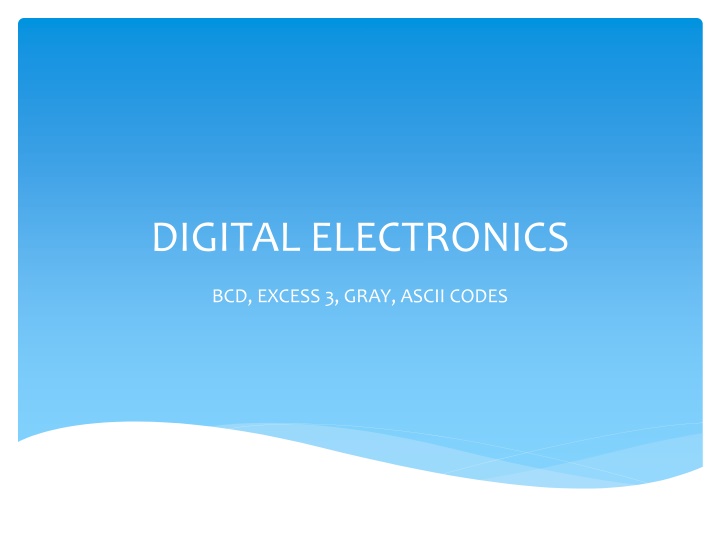
Understanding Binary Codes in Digital Electronics
Explore the world of binary codes in digital electronics, including BCD, Excess-3, Gray codes, and ASCII codes. Learn about the advantages of binary coding and the classification of binary codes into weighted, non-weighted, BCD, alphanumeric, error detecting, and error correcting codes.
Download Presentation

Please find below an Image/Link to download the presentation.
The content on the website is provided AS IS for your information and personal use only. It may not be sold, licensed, or shared on other websites without obtaining consent from the author. If you encounter any issues during the download, it is possible that the publisher has removed the file from their server.
You are allowed to download the files provided on this website for personal or commercial use, subject to the condition that they are used lawfully. All files are the property of their respective owners.
The content on the website is provided AS IS for your information and personal use only. It may not be sold, licensed, or shared on other websites without obtaining consent from the author.
E N D
Presentation Transcript
DIGITAL ELECTRONICS BCD, EXCESS 3, GRAY, ASCII CODES
In the coding, when numbers, letters or words are represented by a specific group of symbols, it is said that the number, letter or word is being encoded. The group of symbols is called as a code. The digital represented, transmitted as group of binary bits. This group is also called as binary code. The binary code is represented by the number as well as alphanumeric letter. data is stored and
Advantages of Binary Code Following is the list of advantages that binary code offers. Binary codes are suitable for the computer applications. Binary codes are suitable for the digital communications. Binary codes make the analysis and designing of digital circuits if we use the binary codes. Since only 0 & 1 are being used, implementation becomes easy.
Classification of binary codes The codes are broadly categorized into following four categories. Weighted Codes Non-Weighted Codes Binary Coded Decimal Code Alphanumeric Codes Error Detecting Codes Error Correcting Codes
Weighted Codes Weighted binary codes are those binary codes which obey the positional weight principle. Each position of the number represents a specific weight. systems of the codes are used to express the decimal digits 0 through 9. In these codes each decimal digit is represented by a group of four bits. Several
Non-Weighted Codes In this type of binary codes, the positional weights are not assigned. The examples of non-weighted codes are Excess-3 code and Gray code.
Excess-3 code The Excess-3 code is also called as XS-3 code. It is non-weighted code used to express decimal numbers. The Excess-3 code words are derived from the 8421 BCD code words adding (0011)2or (3)10 to each code word in 8421. The excess-3 codes are obtained as follows
Gray Code It is the non-weighted code and it is not arithmetic codes. That means there are no specific weights assigned to the bit position. It has a very special feature that, only one bit will change each time the decimal number is incremented as shown in fig. As only one bit changes at a time, the gray code is called as a unit distance code. The gray code is a cyclic code. Gray code cannot be used for arithmetic operation.
GRAY TO BINARY COVERSION To convert a given number in Gray code into equivalent binary, the following rules are applied. 1. The MSB of the Binary is the same as the MSB of the Gray 2. Coding from left to right, add the binary digit generated to the adjacent Gray bit to get the next bit of the binary. Omit the carries if occurs
EXAMPLE Convert the Gray code 1110 to it binary. Step 1 1 1 1 0 Gray 1 Step 2 1 1 1 0 1 0 Step 3 1 1 1 0 Gray 1 0 1 Binary Binary Step 4 1 1 1 0 Gray 1 0 1 Gray 1 Binary Binary
ALPHANUMERIC CODES A binary digit or bit can represent only two symbols as it has only two states '0' or '1'. But this is not enough for communication between two computers because there we need many more symbols for communication. These symbols are required to represent 26 alphabets with capital and small letters, numbers from 0 to 9, punctuation marks and other symbols. The alphanumeric codes are the codes that represent numbers and alphabetic characters. Mostly such codes also represent other characters such as symbol and various instructions information. An alphanumeric code should at least represent 10 digits and 26 letters of alphabet i.e. total 36 items. The following three alphanumeric codes are very commonly used for the data representation. American Standard Code for Information Interchange (ASCII). Extended Binary Coded Decimal Interchange Code (EBCDIC). Five bit Baudot Code. necessary for conveying
ASCII 0 1 2 A ? DECIMAL 48 49 50 65 63 HEX 30 31 32 41 3F 7-BINARY 011 0000 011 0001 011 0010 100 1111 011 1111













